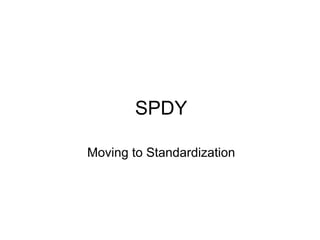
SPDY / W3C
- 2. Why am I talking to the W3C?
- 3. Major Players Already Engaged ● Google: Uses SPDY for all SSL Traffic ○ see about:net-internals in Chrome ● Firefox ○ currently implementing SPDY ● Amazon Kindle Fire ○ launching in a couple of weeks ○ using a very different, but wicked cool model for SPDY
- 4. Why did Google build SPDY?
- 5. What is SPDY? ● Multiplexing ○ Get the data off the client ● Compression ○ HTTP headers are excessive ○ Uplink bandwidth is limited ● Prioritization ○ Today the browser holds back ○ Priorities enable multiplexing ● Server Push ○ Websites do some of this today with data URLs
- 6. Why SSL? ● Technically a myth, SPDY doesn't require SSL. ● Started as a deployment reality ● But we need to secure the net. ○ Not just for finance and banks anymore!
- 7. What about Proxies? ● Proxies cause a lot of problems. ○ example: Pipelining, WebSockets ● We need to transition to explicit proxies instead of implicit ○ This is a hard change. ● SPDY does not address cacheable, secured content. It's simply out-of-scope for the project, but a very worthy project to solve.
- 8. What does Firefox say? From Patrick McManus: Number of parallel connections is exploding: ● NYT home page: 83 connections ● Google+: 64 connections ● Facebook photos: 75 connections He points out: ● This creates horrible NAT pressure. ● 83 concurrent tcp control blocks has potential for enormous queues ● "That means HTTP breaks real time apps - SPDY lets us mitigate that problem"
- 9. What is Kindle Fire doing? Amazon Kindle Internet Service A single SPDY connection for everything.
- 10. Time to Standardize ● It's clear others are finding SPDY compelling ○ Google, Firefox, Amazon, Cotendo, Strangeloop ● We don't want a non-interoperable pile of goo. ● Google is happy to standardize, and individuals from Google would like to play a role. But it will take its own form. ● Planning to do this through IETF in 2012.
- 11. Extra slides
- 13. HTTP Connections Average: 29 connections per page. 25%-tile = 10 50%-tile = 20 75%-tile = 39 95%-tile = 78
- 14. Deployment: Process of Elimination ● Avoid changing the lower-level transport ● Available transports: TCP or UDP. ○ Note: SCTP not an option due to NAT. ● UDP ○ We'd have to re-engineer TCP features. ● That leaves us with TCP. ○ Ok, so which port? 80 or 443?
- 15. Deployment: Port 80 ● Should be our first choice. ● Except HTTP runs on port 80. ● Proxies and intermediates make for a treacherous environment. ○ HTTP/1.1 1999 - Pipelining still not deployed ○ Compression negotiation ● Upgrade header requires a round trip ● WebSockets Data Shows that using HTTP over a non- standard port is less tampered with than port 80. ○ Success rate: ■ HTTP (port 80) 67% ■ HTTP (port 61985) 86% ■ HTTPS (port 443) 95%
- 16. Deployment: Port 443 ● Port 443 runs SSL/TLS. ○ Adds server authentication & encryption ● Handshake is extensible: ○ Next-Protocol-Negotiation www.ietf.org/id/draft-agl-tls-nextprotoneg-00.txt
- 17. Less is More - Conns, Bytes, Packets
- 18. Request Path SPDY (closer to actual) SPDY (human readable) 80 01 00 01 SYN frame 00 00 00 6b stream_id = 1 00 00 00 01 associated_stream_id = 0 00 00 00 00 priority = 1 40 00 00 04 num_headers = 4 06method04post [6]method[4]POST 03url1ahttp://blogger.com/my_blog [3]url[26]http://blogger.com/my_blog 0auser-agent13blahblahblah chrome [10]user-agent[19]blahblahblah chrome 07version08http/1.1 [7]version[8]HTTP/1.1 DATA frame stream_id = 1 00 00 00 01 flags = fin 01 00 00 1f length = 31 here is my very short blog post here is my very short blog post
- 19. Why does SPDY require SSL? ● It doesn't. ● Started as a deployment challenge. ● However, Chrome will never ship a version that is not SSL based, Firefox engineers agree as well.
